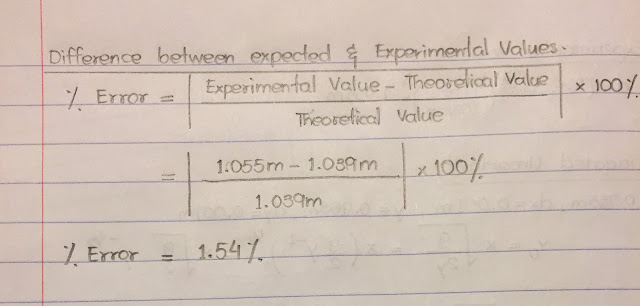Lab#5: Trajectories
May Soe Moe
Lab Partners: Ben Chen, Steven Castro
15-March-2017
Objective: To predict where the ball that was launched from the top of an inclined board would land.
Introduction: The velocity of the objects in projectile motions are calculated separately. We calculate its velocity in x-direction and velocity in y-direction. We knew that the x-velocity and y-velocity are independent of each other and the only relationship between them is time. By finding the time, we can know the position and velocity of the object regardless of being in x or y direction.
Experimental Procedure:
(1) Set up the apparatus as below:
(2) We placed a carbon copy to the floor where we thought the ball would land. We confirmed where it would impact by launching the steel ball as a trial. Then we taped the carbon copy to secure it so that it is not moved by the ball at the time of impact.
(3) We launched the ball five times from the same launching point. We verified that the ball landed in almost exactly the same place for each time.
(4) We measured the height of the table+ the height of the block that was put in between the table and the aluminum b-channel. We also measured the distance from the table's edge to the landed position. The measurements were: h=96.3+/-0.1cm or 0.963 +/- 0.001 m, and x=75.5+/-0.1 cm or 0.755 +/- 0.001 m.
 |
| The height of the table+ The height from table to the v-channel |
 |
| The horizontal distance from the edge of the table |
(5) We calculated the launch speed of the ball from our measurements.
 |
Calculation of the launching speed
(6) We added an inclined plane at the end of the table, touching the v-channel. The angle go the inclined board was measured with bubble level from our phones, which turned out to be 49 Degree. In this case, if we launched the steel ball from the same launching point as before, the ball would stroke the distance somewhere along the board. So, we predicted where the ball would land, and confirmed it by trying once before we recorded where it landed on the carbon paper. Once we were satisfied with where it would land, we taped the carbon paper to record the landed position. We also put some weight at the end of the board so that it would not move during the ball's launching period.
|
(7) We measured the landed distance. We calculated the theoretical distance from the known angle 49 degree and previously calculated launching speed.
 |
Calculation of where the ball landed
|
(8) Once we got the theoretical and experimental values, we calculated the uncertainties of the launching speed, angle, and the distance.
(9) The launched speed was 1.704+/- 0.028 m/s and the distance along the inclined board was 1.055+/-0.331 m.
(10) I calculated the error percentage and it came out to be 1.54%, which is within acceptable range.
Conclusion: The error percentage between our experimental value and theoretical value is 1.54%, which is acceptable as the number is not too big. The uncertainties of this lab could result from the measurements of horizontal distance from the table edge, the distance along the inclined board, the vertical distance from the v-channel to the floor, and the angle. What we used to measure all the distances was a meter-stick, which we had rounded to the approximate value. When we measured the angle, we used the phone app, which was not made for experimental purposes. Another error could be that the board kept moving despite of putting a heavy mass at the foot of the board when the ball was launched. This could result in certain difference of angle. In this case, we neglected the friction force between the surface of the v-channel and the ball. In conclusion, although the theoretical and experimental values of the distance along the board were different, it was within the acceptable range. Through this lab, we learned that the x-velocity and y-velocity during a projectile motion are independent of each other. What relates them is the time. Through the time, we could find out the position, the launching speed and time of the aluminum ball that was in projectile motion.








No comments:
Post a Comment